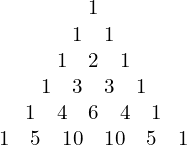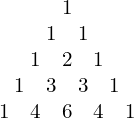Dear Class 12 Samacheer Kalvi students, here are the Business Maths Chapter 5 Numerical Methods Exercise 5.1 Text Book Solutions for your study.
Important Formulas in Numerical Methods
Text Book Solutions to Numerical Methods Exercise 5.2
Text Book Solutions to Numerical Methods Exercise 5.3
Exercise 5.1
![]()
![]()
![]()
![]()
![]()


![]()
![]()
Answer: The equation is:
![]()
| x | 0 | 1 | 2 | 3 | 4 | 5 |
| y | -1 | 0 | 5 | 20 | 51 | 104 |
| x | y | ∆y | ∆2 y | ∆3 y | ∆4 y | ∆5 y |
| 0 | -1 | |||||
| 1 | 0 | 1 | ||||
| 2 | 5 | 5 | 4 | |||
| 3 | 20 | 15 | 10 | 6 | ||
| 4 | 51 | 31 | 16 | 6 | 0 | |
| 5 | 104 | 53 | 22 | 6 | 0 | 0 |
![]()
![]()
![]()
![]()
![]()
![]()
![]()
![]()
![]()
![]()
![]()
![]()
![]()
![]()
![]()
![]()
![]()
![]()
![]()
![]()
![]()
![]()
![Rendered by QuickLaTeX.com 5.\; Evaluate\; \Delta\left[ \dfrac{1}{(x+1)(x+2)} \right]\; by \; taking \; '1'\; as\; the\; interval\; of\; differencing.](https://mightyguru.in/wp-content/ql-cache/quicklatex.com-f6a851f4c740cceb268ac2409e65b9fa_l3.png)
Answer:
![]()
![]()
![Rendered by QuickLaTeX.com = \left[ \dfrac{1}{(x+2)(x+3)} \right]-\left[ \dfrac{1}{(x+1)(x+2)} \right] \\](https://mightyguru.in/wp-content/ql-cache/quicklatex.com-3b65c9ed918ebe4498fd17bebe8c2d09_l3.png)
![]()
![]()
6. Find the missing entry in the following table.
| x | 0 | 1 | 2 | 3 | 4 |
| yx | 1 | 3 | 9 | – | 81 |
Answer: Since only 4 values are given:
![]()
![]()
![]()
![]()
![]()
![]()
![]()
![]()
![]()
![]()
![]()
![]()
![]()
![]()
![]()
7. Following are the population of a district.
| Year(x) | 1881 | 1891 | 1901 | 1911 | 1921 | 1931 |
| Population (y) in Thousands | 363 | 391 | 421 | – | 467 | 501 |
Find the population of the year 1911.
Answer: Since only 5 values are given:
![]()
![]()

![]()
![]()
![]()
![]()
![]()
![]()
![]()
![]()
![]()
![]()
Since the population is in thousands, population for the year 1991 = 445.2 x 1000= 4,45,200.
8. Find the missing entries from the following.
| x | 0 | 1 | 2 | 3 | 4 | 5 |
| y=f(x) | 0 | – | 8 | 15 | – | 35 |
Answer: Since only 4 values of f(x) are given:
![]()
![]()

![]()
![]()
![]()
![]()
![]()
![]()
![]()
![]()
![]()
![]()
![]()
![]()
![]()
![]()
![]()
![]()
![]()
![]()
![]()
![]()
![]()
![]()
![]()
![]()
![]()
![]()
Leave a Reply